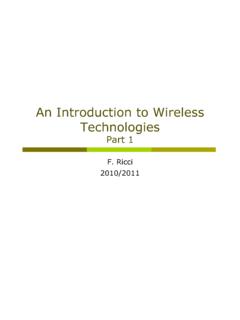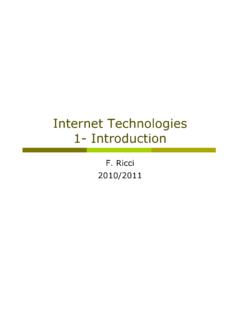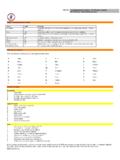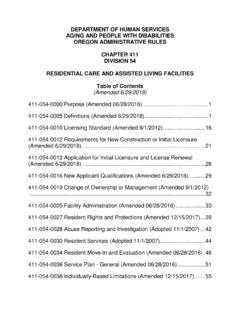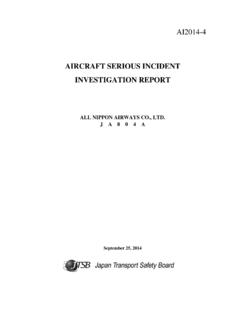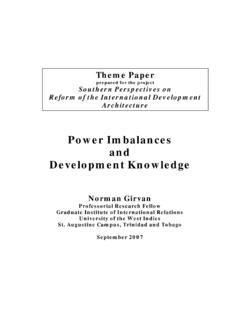Transcription of An Introduction to Wireless Technologies - unibz
1 An Introduction to Wireless Technologies Part 1 F. Ricci 2010/2011 Content Wireless communication standards Computer Networks Reference model for a network architecture Frequencies and regulations Wireless communication Technologies Signals Bandwidth limited signals Signal modulation Data transfer rate Signal propagation Most of the slides of this lecture come from prof. Jochen Schiller s didactical material for the book Mobile Communications , Addison Wesley, 2003. Analogue vs. Digital Analogue transmission of analogue data The air pressure variations (analogue data) are converted (microphone) into an electrical analog signal in which either the instantaneous voltage or current is directly proportional to the instantaneous air pressure and then transmitted ( , traditional phone or radio) Analogue transmission of digital data The electric analog signal is digitized, or converted to a digital signal, through an Analog-to-Digital converter and then modulated into analogue signals and trasmitted ( , digital phones as GSM).
2 Wireless systems: overview cellular phones satellites Wireless LAN cordless phones 1992: GSM-900 1994: GSM-1800 2001: IMT-2000 (UMTS) 1987: CT1+ 1982: Inmarsat-A 1992: Inmarsat-B Inmarsat-M 1998: Iridium 1989: CT 2 1991: DECT 199x: proprietary 1997: HYPERLAN IEEE 1999: , Bluetooth 1988: Inmarsat-C analogue digital 1991: D-AMPS 1991: CDMA 1981: NMT 450 1986: NMT 900 1980: CT0 1984: CT1 1983: AMPS 1993: PDC 4G fourth generation: when and how? 2000: GPRS 2000: IEEE 200?: Fourth Generation (Internet based) Cellular Generations First Analog, circuit-switched (AMPS, TACS) Second Digital, circuit-switched (GSM) 10 Kbps Advanced second Digital, circuit switched (HSCSD High-Speed Circuit Switched Data), Internet-enabled (WAP) 10 Kbps Digital, packet-switched, TDMA (GPRS, EDGE) 40-400 Kbps Third Digital, packet-switched, Wideband CDMA (UMTS) 2 Mbps Fourth Data rate 100 Mbps; achieves telepresence Nokia N95 Operating Frequency: WCDMA2100 (HSDPA), EGSM900, GSM850/1800/1900 MHz (EGPRS) Memory: Up to 160 MB internal dynamic memory.
3 Memory card slot - microSD memory cards (up to 2 GB) Display: " QVGA (240 x 320 pixels) TFT ambient light detector - up to 16 million colors Data Transfer: WCDMA 2100 (HSDPA) with simultaneous voice and packet data (Packet Switching max speed UL/DL= 384 , Circuit Switching max speed 64kbps) Dual Transfer Mode (DTM) support for simultaneous voice and packet data connection in GSM/EDGE networks - max speed DL/UL: kbits/s EGPRS class B, multi slot class 32, max speed DL/UL= 296 / kbits/s Services E-mail file 10 Kbyte Web Page 9 Kbyte Text File 40 Kbyte Large Report 2 Mbyte Video Clip 4 Mbyte Film with TV Quality 2G 8 sec 9 sec 33 sec 28 min 48 min 1100 hr PSTN 3 sec 3 sec 11 sec 9 min 18 min 350 hr ISDN 1 sec 1 sec 5 sec 4 min 8 min 104 hr 2G+ sec sec 3 sec 2 min 4 min 52 hr UMTS/3G sec sec 7 sec 14 sec >5hr Source: UMTS Forum Computer Networks A computer network is two or more computers connected together using a telecommunication system for the purpose of communicating and sharing resources Why they are interesting?
4 Overcome geographic limits Access remote data Separate clients and server Goal: Universal Communication (any to any) Network Type of Networks PAN: a personal area network is a computer network (CN) used for communication among computer devices (including telephones and personal digital assistants) close to one person Technologies : USB and Firewire (wired), IrDA and Bluetooth ( Wireless ) LAN: a local area network is a CN covering a small geographic area, like a home, office, or group of buildings Technologies : Ethernet (wired) or Wi-Fi ( Wireless ) MAN: Metropolitan Area Networks are large CNs usually spanning a city Technologies : Ethernet (wired) or WiMAX ( Wireless ) WAN: Wide Area Network is a CN that covers a broad area, , cross metropolitan, regional, or national boundaries Examples: Internet Wireless Technologies : HSDPA, EDGE, GPRS, GSM. Reference Model Application Transport Network Data Link Physical Medium Data Link Physical Application Transport Network Data Link Physical Data Link Physical Network Network Radio Base transceiver station Base station controller Reference model Physical layer: conversion of stream of bits into signals carrier generation - frequency selection signal detection encryption Data link layer: accessing the medium multiplexing - error correction synchronization Network layer: routing packets addressing -handover between networks Transport layer: establish an end-to-end connection quality of service flow and congestion control Application layer.
5 Service location support multimedia Wireless access to www Wireless Network The difference between wired and Wireless is the physical layer and the data link layer Wired network technology is based on wires or fibers Data transmission in Wireless networks take place using electromagnetic waves which propagates through space (scattered, reflected, attenuated) Data are modulated onto carrier frequencies (amplitude, frequency) The data link layer (accessing the medium, multiplexing, error correction, synchronization) requires more complex mechanisms. Waves' interference IEEE standard mobile terminal access point fixed terminal application TCP PHY MAC IP MAC PHY application TCP PHY MAC IP MAC PHY LLC infrastructure network LLC LLC Network layer Transport layer Data link layer Physical link l. CSMA/CA = Carrier Sense Multiple Access / Collision Avoidance CSMA/CA = Carrier Sense Multiple Access / Collision Detection CSMA/CD CSMA/CA Request to Send (RTS) packet sent by the sender S, and a Clear to Send (CTS) packet sent by the intended receiver R.
6 Alerting all nodes within range of the sender, receiver or both, to not transmit for the duration of the main transmission. Mobile Communication Technologies Local Wireless networks WLAN WiFi Personal Wireless nw WPAN Bluetooth ZigBee Wireless distribution networks WMAN (Broadband Wireless Access) (Mobile Broadband Wireless Access) + Mobility WiMAX Bluetooth A standard permitting Wireless connection of: Personal computers Printers Mobile phones Handsfree headsets LCD projectors Modems Wireless LAN devices Notebooks Desktop PCs PDAs Bluetooth Characteristics Operates in the GHz band - Packet switched 1 milliwatt - as opposed to 500 mW cellphone Low cost 10m to 100m range Uses Frequency Hop (FH) spread spectrum, which divides the frequency band into a number of hop channels. During connection, devices hop from one channel to another 1600 times per second Data transfer rate 1-2 megabits/second (GPRS is ~50kbits/s) Supports up to 8 devices in a piconet (= two or more Bluetooth units sharing a channel).
7 Built-in security Non line-of-sight transmission through walls and briefcases Easy integration of TCP/IP for networking. Wi-Fi Wi-Fi is a technology for WLAN based on the IEEE (a, b, g) specifications Originally developed for PC in WLAN Increasingly used for more services: Internet and VoIP phone access, gaming, .. and basic connectivity of consumer electronics such as televisions and DVD players, or digital cameras, .. In the future Wi-Fi will be used by cars in highways in support of an Intelligent Transportation System to increase safety, gather statistics, and enable mobile commerce (IEEE ) Wi-Fi supports structured (access point) and ad-hoc networks (a PC and a digital camera). Wi-Fi An access point (AP) broadcasts its SSID (Service Set Identifier, "Network name") via packets (beacons) broadcasted every 100 ms at 1 Mbit/s Based on the settings ( the SSID), the client may decide whether to connect to an AP Wi-Fi transmission, as a non-circuit-switched wired Ethernet network, can generate collisions Wi-Fi uses CSMA/CA (Carrier Sense Multiple Access with Collision Avoidance) to avoid collisions CSMA = the sender before transmitting it senses the carrier if there is another device communicating then it waits a random time an retry CA = the sender before transmitting contacts the receiver and ask for an acknowledgement if not received the request is repeated after a random time interval.
8 WiMAX IEEE : Broadband Wireless Access / WirelessMAN / WiMax (Worldwide Interoperability for Microwave Access) Connecting Wi-Fi hotspots with each other and to other parts of the Internet Providing a Wireless alternative to cable and DSL for last mile broadband access Providing high-speed mobile data and telecommunications services Providing Nomadic connectivity 75 Mbit/s up to 50 km LOS, up to 10 km NLOS; 2-5 GHz band Initial standards without roaming or mobility support adds mobility support, allows for roaming at 150 km/h. Wireless Telephony SOURCE: AIR LINK PUBLIC SWITCHED TELEPHONE NETWORK WIRED Advantages of Wireless LANs Very flexible within the reception area Ad-hoc networks without previous planning possible (almost) no wiring difficulties ( historic buildings, firewalls) More robust against disasters like, , earthquakes, fire - or users pulling a Wireless networks disadvantages Higher loss-rates due to interference emissions of, , engines, lightning Restrictive regulations of frequencies frequencies have to be coordinated, useful frequencies are almost all occupied Low data transmission rates local some Mbit/s, regional currently, , 53kbit/s with GSM/GPRS Higher delays, higher jitter connection setup time with GSM in the second range, several hundred milliseconds for other Wireless systems Lower security, simpler active attacking radio interface accessible for everyone, base station can be simulated, thus attracting calls from mobile phones Always shared medium secure access mechanisms important Electromagnetic Waves Electromagnetic radiation (EMR)
9 Takes the form of self-propagating waves in a vacuum or in matter It consists of electric and magnetic field components which oscillate in phase perpendicular to each other and perpendicular to the direction of energy propagation A wave is a disturbance that propagates through space and time, usually with transference of energy The wavelength (denoted as ) is the distance between two sequential crests The period T is the time for one complete cycle for an oscillation of a wave The frequency f is how many periods per unit time (for example one second) and is measured in hertz: f=1/T the velocity of a wave is the velocity at which variations in the shape of the wave's amplitude propagate through space: v = *f Wave propagation Waves with different frequencies and length period 1 GHz = 30cm 3 GHz = 10cm Electromagnetic Spectrum SOURCE: LIGHT RADIO HARMFUL RADIATION VHF = VERY HIGH FREQUENCY UHF = ULTRA HIGH FREQUENCY SHF = SUPER HIGH FREQUENCY EHF = EXTRA HIGH FREQUENCY 4G CELLULAR 56-100 GHz 3G CELLULAR GHz 1G, 2G CELLULAR UWB GHz c = *f c= 299 792 458 m/s ~ 3*108 m/s Frequencies and regulations ITU-R (International Telecommunication Union Radiocommunication) holds auctions for new frequencies, manages frequency bands worldwide Values in MHz Signals I Signals are a function of time and location Physical representation of data Users can exchange data through the transmission of signals The Layer 1 is responsible for conversion of data, , bits, into signals and viceversa Signal parameters of periodic signals: period T, frequency f=1/T, amplitude A, phase shift sine wave as special periodic signal for a carrier.
10 S(t) = At sin(2 ft t + t) Sine waves are of special interest as it is possible to construct every periodic signal using only sine and cosine functions (Fourier equation). Fourier analysis of periodic signals g(t)=12c+ann=1 sin(2 nft)+bnn=1 cos(2 nft)1 0 1 0 t t ideal periodic signal real composition (based on harmonics) f=1/T is the fundamental frequency = first harmonic It is the lowest frequency present in the spectrum of the signal. Different representations of signals amplitude (amplitude domain) frequency spectrum (frequency domain) phase state diagram (amplitude M and phase in polar coordinates) Composed signals transferred into frequency domain using Fourier transformation Digital signals need: infinite frequencies for perfect transmission modulation with a carrier frequency for transmission (analog signal!) Signals II f [Hz] A [V] I= M cos Q = M sin A [V] t[s] Sound spectrum of two flutes Bandwidth-Limited Signals A binary signal and its root-mean-square Fourier amplitudes.




